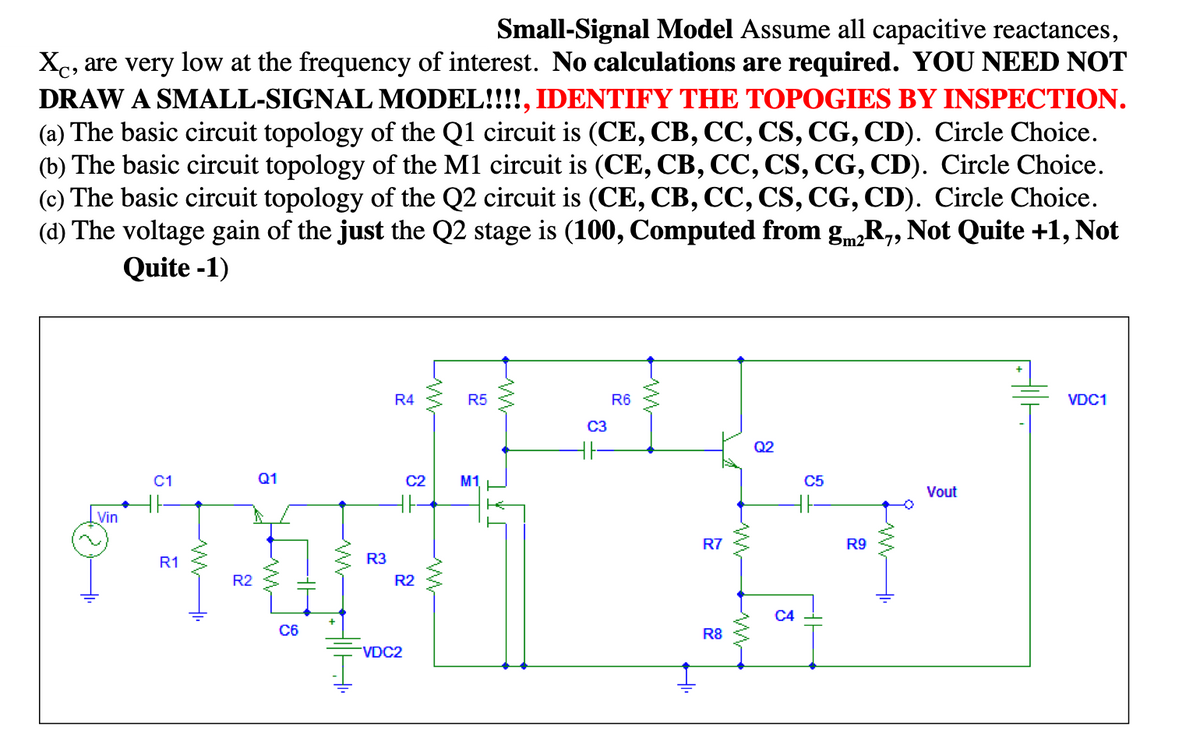Small-Signal Model Assume all capacitive reactances, Xc, are very low at the frequency of interest. No calculations are required. YOU NEED NOT DRAW A SMALL-SIGNAL MODEL!!!!, IDENTIFY THE TOPOGIES BY INSPECTION. (a) The basic circuit topology of the Q1 circuit is (CE, CB, CC, CS, CG, CD). Circle Choice. (b) The basic circuit topology of the M1 circuit is (CE, CB, CC, CS, CG, CD). Circle Choice. (c) The basic circuit topology of the Q2 circuit is (CE, CB, CC, CS, CG, CD). Circle Choice.
Small-Signal Model Assume all capacitive reactances, Xc, are very low at the frequency of interest. No calculations are required. YOU NEED NOT DRAW A SMALL-SIGNAL MODEL!!!!, IDENTIFY THE TOPOGIES BY INSPECTION. (a) The basic circuit topology of the Q1 circuit is (CE, CB, CC, CS, CG, CD). Circle Choice. (b) The basic circuit topology of the M1 circuit is (CE, CB, CC, CS, CG, CD). Circle Choice. (c) The basic circuit topology of the Q2 circuit is (CE, CB, CC, CS, CG, CD). Circle Choice.
Introductory Circuit Analysis (13th Edition)
13th Edition
ISBN:9780133923605
Author:Robert L. Boylestad
Publisher:Robert L. Boylestad
Chapter1: Introduction
Section: Chapter Questions
Problem 1P: Visit your local library (at school or home) and describe the extent to which it provides literature...
Related questions
Question

Transcribed Image Text:Small-Signal Model Assume all capacitive reactances,
Xc, are very low at the frequency of interest. No calculations are required. YOU NEED NOT
DRAW A SMALL-SIGNAL MODEL!!!!, IDENTIFY THE TOPOGIES BY INSPECTION.
(a) The basic circuit topology of the Q1 circuit is (CE, CB, CC, CS, CG, CD). Circle Choice.
(b) The basic circuit topology of the M1 circuit is (CE, CB, CC, CS, CG, CD). Circle Choice.
(c) The basic circuit topology of the Q2 circuit is (CE, CB, CC, CS, CG, CD). Circle Choice.
(d) The voltage gain of the just the Q2 stage is (100, Computed from gmR,, Not Quite +1, Not
Quite -1)
R4
R5
R6
VDC1
C3
Q2
C1
Q1
C2
M1
C5
Vout
Vin
R7
R9
R1
R3
R2
R2
C4
C6
R8
VDC2
Expert Solution
This question has been solved!
Explore an expertly crafted, step-by-step solution for a thorough understanding of key concepts.
Step by step
Solved in 2 steps with 2 images

Knowledge Booster
Learn more about
Need a deep-dive on the concept behind this application? Look no further. Learn more about this topic, electrical-engineering and related others by exploring similar questions and additional content below.Recommended textbooks for you

Introductory Circuit Analysis (13th Edition)
Electrical Engineering
ISBN:
9780133923605
Author:
Robert L. Boylestad
Publisher:
PEARSON

Delmar's Standard Textbook Of Electricity
Electrical Engineering
ISBN:
9781337900348
Author:
Stephen L. Herman
Publisher:
Cengage Learning

Programmable Logic Controllers
Electrical Engineering
ISBN:
9780073373843
Author:
Frank D. Petruzella
Publisher:
McGraw-Hill Education

Introductory Circuit Analysis (13th Edition)
Electrical Engineering
ISBN:
9780133923605
Author:
Robert L. Boylestad
Publisher:
PEARSON

Delmar's Standard Textbook Of Electricity
Electrical Engineering
ISBN:
9781337900348
Author:
Stephen L. Herman
Publisher:
Cengage Learning

Programmable Logic Controllers
Electrical Engineering
ISBN:
9780073373843
Author:
Frank D. Petruzella
Publisher:
McGraw-Hill Education

Fundamentals of Electric Circuits
Electrical Engineering
ISBN:
9780078028229
Author:
Charles K Alexander, Matthew Sadiku
Publisher:
McGraw-Hill Education

Electric Circuits. (11th Edition)
Electrical Engineering
ISBN:
9780134746968
Author:
James W. Nilsson, Susan Riedel
Publisher:
PEARSON

Engineering Electromagnetics
Electrical Engineering
ISBN:
9780078028151
Author:
Hayt, William H. (william Hart), Jr, BUCK, John A.
Publisher:
Mcgraw-hill Education,